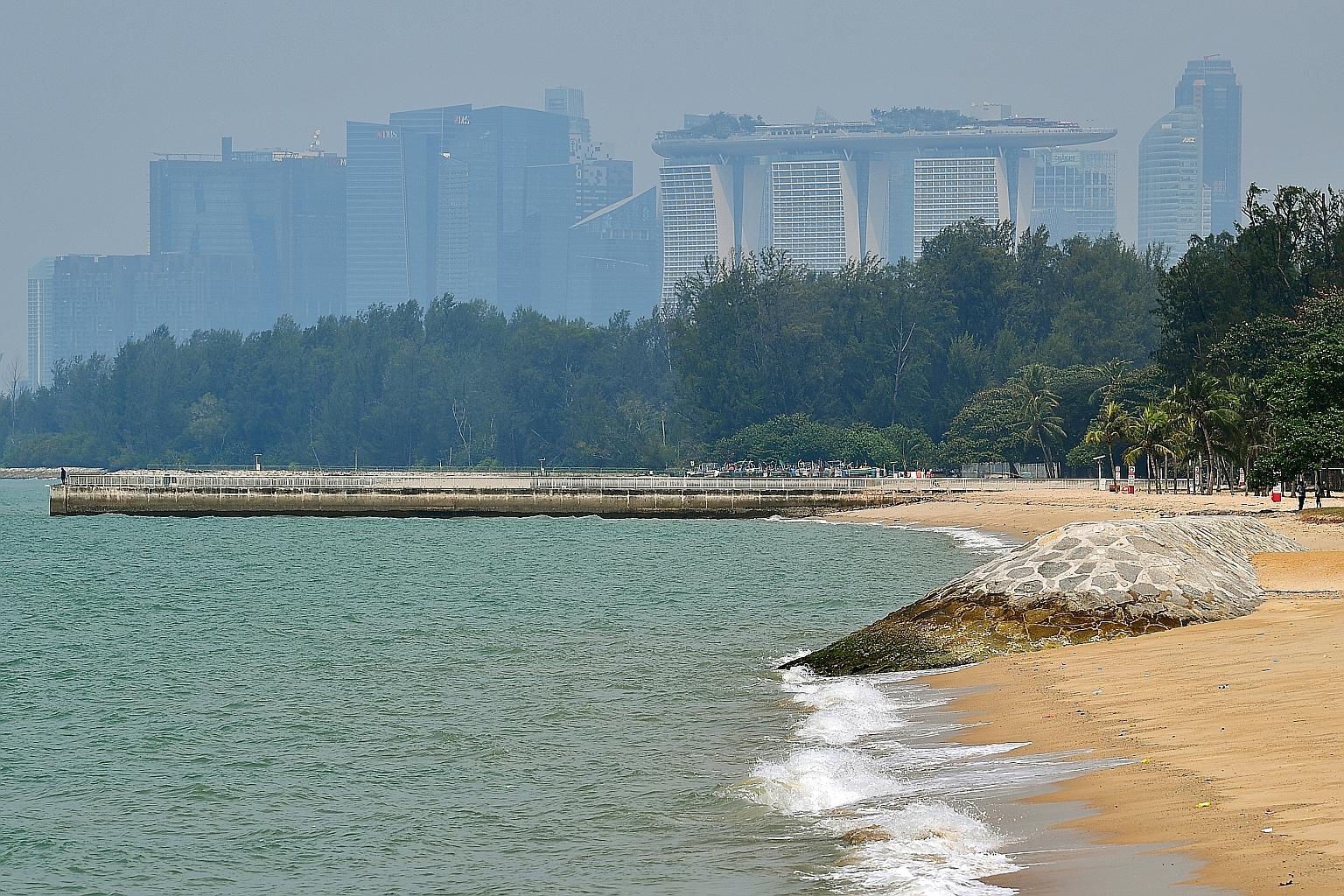Report shows rising sea levels hitting close to home in S'pore
Island's average sea level at 14cm above pre-1970 levels brought on by warming oceans, melting of glaciers
Sign up now: Get ST's newsletters delivered to your inbox

Breakwaters like the one on the right protect sandy beaches and reclaimed shores from waves and erosion. Prime Minister Lee Hsien Loong said Singapore would need to spend $100 billion over the long term to buffer its coast from the rising tides.
ST PHOTO: LIM YAOHUI
Follow topic:
As the world warms and ice caps melt, global sea levels are rising, including around Singapore.
The average sea level around the island today is 14cm above pre-1970 levels, said the Meteorological Service Singapore (MSS) yesterday in its annual climate assessment report.
"Warming oceans cause sea level to rise," said the MSS report. Water expands when heated, and this contributes to sea level rise. "Similarly, melting of glaciers, Greenland and Antarctica ice sheets ultimately reach the ocean, thus further increasing sea level," it added.
Data from tide gauges has shown that global sea level has been rising at a rate of 1.2mm to 1.9mm a year in the 20th century, the report noted.
The thermal expansion of water was the main driver of sea level rise in the 20th century, said sea level rise expert Benjamin Horton from the Nanyang Technological University. But accelerating rates of ice melt from the world's ice sheets were exacerbating the situation in the 21st century, he added.
MSS said that since 1993, when high-precision satellite data was available for sea level monitoring, the global average sea level rose at a rate of about 3.24mm per year. Sea levels reached about 90mm above the 1993 level - the highest recorded so far - last year, noted the MSS report.
Prof Horton said: "If all of Greenland is melted, it will contribute 6m to sea level rise." But the impact is much greater for Antarctica, he added - if the Antarctic Ice Sheet melts completely, sea levels could go up by about 60m.
The MSS report follows another released by the United Nations climate science body last September, which also found that if warming continued unabated, sea levels may rise by several metres in the centuries ahead. Earlier estimates had said sea levels could rise by about 1m by 2100.
The study of how sea levels can impact coastlines is a complex one. For one, sea level rise is not uniform, but varies regionally and at different time scales.
Singapore, for example, might experience higher rates of sea level rise than the global mean, said Prof Horton. "If an ice sheet melts, its gravitational attraction decreases and sea levels around it can go down," explains Prof Horton."Conversely, regions far from a melting ice sheet, such as Singapore, will see a rise in sea level greater than the global average."
Sea levels can also vary over shorter periods.
-
30%
Percentage of Singapore that is less than 5m above the mean sea level, making it vulnerable to sea level rise.
For example, during the north-east monsoon - usually the region's rainy season for the year - sea levels can rise by up to 0.2m, said MSS.
Sea levels can also vary during the occurrence of natural climate phenomena, such as El Nino events, which can occur every two to seven years. The last major El Nino event occurred in 2015.
The MSS said it is studying how sea levels around Singapore were affected by the 2015 El Nino event, as well as the positive phase of the Indian Ocean Dipole - another climate phenomenon similar to El Nino, but centred on the Indian Ocean - which occurred last year.
"This is currently being studied and will be part of a soon-to-be published journal paper," said the MSS spokesman, adding that more details will be released later.
Singapore, as a low-lying nation with about 30 per cent of the island less than 5m above the mean sea level, is well-aware of its vulnerability to sea level rise and is taking steps to mitigate the impact.
Last August, Prime Minister Lee Hsien Loong said Singapore would need to spend $100 billion over the long term to buffer its coast from the rising tides. Last month, Deputy Prime Minister Heng Swee Keat said Singapore's new coastal and flood protection fund will get its first injection of $5 billion.
Scientific research is also ongoing. The MSS spokesman: "The National Sea Level Programme will use this information to better understand the sea level variability. This is crucial in order to better assess future projections of sea level rise, since the long-term trends are superimposed onto this variability."

